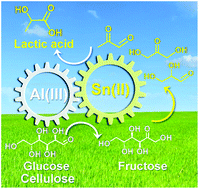Transformation of cellulose and related carbohydrates into lactic acid with bifunctional Al(iii)–Sn(ii) catalysts†
Abstract
The catalytic transformation of cellulose into valuable chemicals such as lactic acid under mild conditions represents a promising route for the efficient utilization of renewable biomass. Here, we report that the combination of Al(III) and Sn(II) cations can efficiently catalyse the conversion of cellulose and related carbohydrates into lactic acid in water. Al(III)–Sn(II) is the most efficient combination for lactic acid formation among the many dual cations investigated. Al(III) and Sn(II) with a molar ratio of 1/1 work cooperatively, providing lactic acid with yields of 90%, 81% and 65% in the conversions of fructose, glucose and cellulose, respectively. The formation of lactic acid involves a series of tandem steps including the hydrolysis of cellulose to glucose, the isomerisation of glucose to fructose, the retro-aldol fragmentation of fructose to C3 intermediates and the subsequent conversion of the C3 intermediates to lactic acid. Our experimental and computational studies suggest that Al(III) mainly catalyses the isomerisation of glucose or the C3 intermediates, whereas Sn(II) is primarily responsible for the retro-aldol fragmentation. The combination of the two cations enables the reaction to proceed smoothly with few side reactions, providing outstanding catalytic performances for lactic acid production from cellulose or the related carbohydrates.

- This article is part of the themed collection: International Symposium on Green Chemistry 2017


 Please wait while we load your content...
Please wait while we load your content...